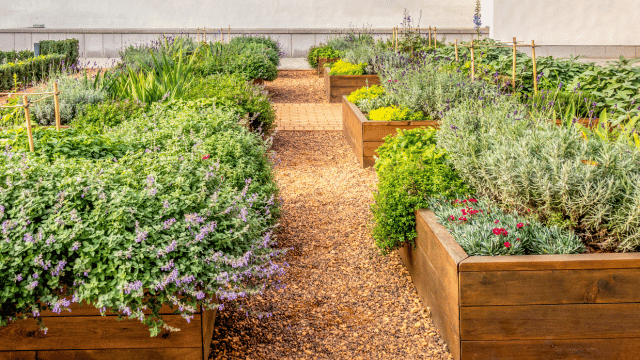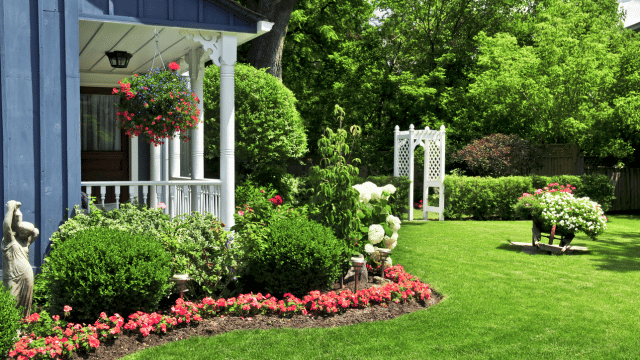People who love gardening are always looking for ways to get the most out of their plants. Raised plant beds are one way that has become more popular over the past few years. You can add raised flower beds to any garden and get a lot of benefits from them. This article will talk about the benefits of raised planting beds, the different kinds that are out there, how to pick the right spot and materials, and how to build your own raised planting bed step by step.
Why raised plant beds are good
There are several reasons why raised planting beds are better than standard ways of gardening. First and foremost, they drain better than beds that are level with the ground. Extra water can easily drain away, keeping the soil from getting too wet and promoting healthy root growth. Also, the better ventilation makes it less likely that plants will get fungal diseases that are bad for them.
You can also control the quality of the dirt, which is another benefit of raised planting beds. You can make the beds the best place for your plants to grow by filling them with good dirt. You can change the dirt to meet the needs of different plants, which will help them grow and produce the most.Also, raised garden beds are easier to get to, especially for people who have trouble moving around. Because it is higher, you don’t have to bend over or sit as much to take care of your plants. This makes it easier to do without hurting your back or knees. Everyone can enjoy gardening more and feel more at ease with this convenience.
Benefits of Raised Planting Beds
You can pick from different kinds of raised planters based on your tastes and the space you have. Common types are raised beds made of wood, raised beds made of cinder blocks, and raised beds made of stone or brick.Many people choose wooden raised beds because they can be used in many ways and are easy to build. They can be made in different shapes and sizes to fit your yard. Wooden raised beds made from cedar and oak are great because they don’t rot or decay naturally.Another choice for raised beds that don’t need much work is cinder block beds. You can stack the blocks to make your bed the height and shape you want. They last a long time and keep the soil warm in the winter because they are very good at insulating.A better-looking choice is to use stone or brick for the raised beds. Your garden plan can be built to fit right in with them, giving your outdoor space a touch of class. On the other hand, building these kinds of raised beds might take more work and special skills.
Types of Raised Planting Beds
Putting your raised bed in the right place is very important for the success of your garden. Most plants need at least six hours of direct sunshine every day, so pick a spot that gets that much light all day. Do not put your raised bed in a place that will get covered or under trees that could block the sun.Think about how easy it is to get to the place as well. Make sure the raised bed is easy to get to so you can water, weed, and collect it. You should be able to get to a water source easily and put it near your farming tools.You should also think about how close it is to other buildings or plants. Make sure the raised bed is not too close to buildings or walls that could block air flow or shade the plants. Leave enough room between beds so that it’s easy to move and clean.
How to Choose the Right Materials for Your Raised Bed
Picking the right materials for your raised bed is important if you want it to last and work well. If you choose wooden raised beds, make sure to use wood that hasn’t been treated and won’t rot naturally. Do not use pressure-treated wood because it might have chemicals in it that are bad for you and can get into the dirt.For raised beds made of cement blocks, choose blocks that are made to be used outside. These blocks will last longer and won’t break down easily. Make sure they are clean and don’t have any chemicals left on them that could hurt your plants.If you decide to build raised beds out of stone or brick, make sure the materials are strong and will last. Stones or bricks that come from nature are best because they look natural and lovely and last a long time.
Building Your Raised Planting Bed
An easy task that can be completed with basic tools and supplies is building your raised flower bed. To begin, use stakes and string to mark the bed’s desired measurements. This will be used as a guide while the building is being done.To begin, get the area where the bed will go ready. Get rid of any weeds or grass in the area and try to make the ground as level as you can. This will make sure that the base of your raised bed is stable.Next, use the materials you picked to put together the sides of the bed. If you are using wood, use screws or nails to connect the boards. For beds made of cinder blocks or stones, stack the stones or blocks so that they are level and safe.Fill the bed with good soil, leaving about an inch of room at the top, once the sides are in place. Level off the top of the dirt and water it well to make it settle.
Choosing the Right Plants for Raised Beds
For your raised planting bed to work, you must properly prepare the dirt. Since soil in raised beds dries out faster than soil in the ground, it is important to make it better at holding water and nutrients.To begin, add organic matter to the soil, like compost or dung that has been broken down. This will make it stronger, help it hold more water, and give your plants the nutrients they need. Make sure the organic matter is evenly spread out by mixing it into the dirt well.You might want to test your dirt to find out its pH level and any nutrient deficiencies. This will help you change the makeup of the soil as needed. A pH range of 6.0 to 7.0 is good for most plants because it is partly acidic and partly neutral.Check the amount of moisture in your raised bed often and water it as needed. Raised beds dry out more quickly, especially in the hot summer months, so make sure you wet your plants often.
How to Pick the Best Plants for Raised Beds
When choosing plants for your raised beds, think about how they grow, how much light they need, and how far apart they need to be. Plan ahead because some plants, like cucumbers and tomatoes, do better with trellising or stakes.You can grow herbs and leafy greens in raised beds because they don’t need deep roots and can be picked all through the growth season. There are many plants that do well in raised beds, such as lettuce, spinach, basil, and parsley.Raised beds are another way to grow root veggies like beets, carrots, and radishes. Make sure the dirt is not too tight and can drain well so the roots can grow properly.Don’t put too many plants in your raised bed so that they have to compete for nutrients and sunshine. To get the best growth and yield, make sure you follow the rules for how far apart each plant should be.
Maintenance and Care for Raised Planting Beds
For your raised flower beds to last and produce well, they need to be properly cared for and maintained. Check for weeds often and get rid of them right away to keep your plants from having to compete with them. Putting mulch on top of the bed can help keep the soil wet and stop weeds from growing.Keep an eye out for diseases and pests, and take the right steps to get rid of them. Regularly check your plants for any signs of damage or pests. If you catch pests or diseases early, you can stop them from spreading and lessen the damage they do to your yard.Make sure to water your raised bed regularly so that the dirt stays evenly wet. Don’t water too much, because that can cause root rot and other problems. To get water straight to the roots, you could use a drip irrigation system or soaker hoses.Regularly fertilize your plants to give them the nutrients they need. Organic fertilizers, like compost or manure that has broken down, are great for raised beds because they make the soil more fertile and help plants stay healthy over time.
Conclusion
Raised planting beds have many advantages, such as better drainage and soil control, as well as better looks and ease of entry. If you follow the steps in this piece, you can get the most out of gardening and make a garden with raised planting beds that grows well. You should prepare the dirt properly and choose the right plants for best growth whether you use stone, cinder block, or wooden beds. Your raised growing beds will give you plenty of food and a fun gardening experience if you take care of them regularly.


